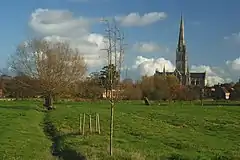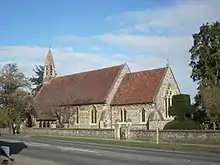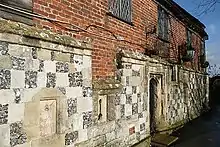Harnham
Harnham is a suburb of the city of Salisbury in Wiltshire, England, centred about 0.6 miles (1 km) south of Salisbury Cathedral and across the River Avon. Harnham is split into the areas of West Harnham and East Harnham.
| Harnham | |
|---|---|
 View across the water meadows from lower Harnham | |
 Harnham Location within Wiltshire | |
| Population | 4,992 (Ward, 2011)[1] |
| OS grid reference | SU 134 290 |
| Civil parish | |
| Unitary authority | |
| Ceremonial county | |
| Region | |
| Country | England |
| Sovereign state | United Kingdom |
| Post town | Salisbury |
| Postcode district | SP2 |
| Dialling code | 01722 |
| Police | Wiltshire |
| Fire | Dorset and Wiltshire |
| Ambulance | South Western |
| UK Parliament | |
History
Early history
The area has had human habitation since the Iron Age; a settlement is marked on Ordnance Survey maps underneath several modern houses in Harnwood Road/Old Blandford Road, a straight Roman Road.[n 1][2]
Middle Ages
Until the 19th century formation of urban and rural districts, the area lay within the Cawdon and Cawsworth Hundred of Wiltshire.[3]
Road access to the city was improved in 1244 by the building of Ayleswade bridge, in two sections across an island in the Avon, leading traffic from the south through Harnham instead of the older route to the west through Wilton.[4] The old bridge survives inside an outer casing added in the 16th or 17th century.[5]
St Nicholas Hospital, sometimes described as being in Harnham,[6] was built earlier than the bridge, just north of it.[7][8] Parts of the medieval almshouses survive, including two chapels,[9] and the site continues to provide sheltered housing for a Christian community.[10]
The manors of East and West Harnham were still owned by the 13th-century College of the Valley Scholars, which stood next to St Nicholas Hospital, when it was dissolved in 1542. The next year, they were sold by the Crown to Sir Michael Lister, a king's servant.[11]
Post Industrial Revolution
In 1848, Samuel Lewis (publisher) described the settlement in a topographical dictionary based partly on 1841 census statistics:
- East Harnham, a tything, in the parish of Britford, union of Alderbury, hundred of Cawden and Cadworth, Salisbury and Amesbury, and south divisions of Wilts., 1½ mile (S. E. by S.) from the city of Salisbury; containing 411 inhabitants.
- West Harnham (St George) a parish, in the union of Alderbury, hundred of Cawden and Cadworth, Salisbury and Amesbury, and S. divisions of Wilts, 1½ mile (S. W. by W.) from Salisbury; containing 256 inhabitants. The living is annexed to the vicarage of Coombe-Bisset; the tithes were partly commuted for land and money payments under an Inclosure Act in 1783; and the remainder have been commuted for a rentcharge of £50.[12]
Civil parishes
East Harnham spent less than ten years as a civil parish. Anciently a tything of Britford, a new ecclesiastical parish was created in 1855 after the opening of All Saints church.[13] East Harnham continued to be part of Britford civil parish until 1896, when it was made a separate civil parish. In 1904, when Salisbury became a single civil parish, East Harnham was abolished and its area transferred to West Harnham, Salisbury and Britford.[4][14]
The ancient parish of West Harnham was separated from Netherhampton to its west by the course of a Roman road.[15] West Harnham civil parish was established in 1904, gaining part of East Harnham. In 1927 its urban part was transferred to Salisbury, and in 1934 the remainder was transferred to Netherhampton.[16]
Geography
Harnham is a suburb in the southwest of Salisbury and is linked to the city by road via the Ayleswade Bridge in East Harnham, originally built across the Avon in 1244, and by foot via the Town Path across the "historic and important landscape"[17] of the Harnham Water Meadows in West Harnham.
The meadows lie between two branches of the River Nadder and extend into the outskirts of the city. They are part of an extensive irrigation system of floated water meadows, dating from the mid-seventeenth century. Now a Site of Special Scientific Interest known as East Harnham Meadows, they are still used for grazing and were voted the Best View in Britain by Country Life magazine in 2002. The meadows were made famous in John Constable's painting "Salisbury Cathedral – A View from the Water Meadow". The meadows are managed by the Harnham Water Meadows Trust, and owned by the Trust jointly with the Dean and Chapter of Salisbury Cathedral.[18]

In the 13th century, Salisbury sited its new Cathedral on the flat fertile plain encircled by the Avon and protected by Harnham Hill, a chalk escarpment which rises steeply to the south. Harnham Slope comprises an area of woodland on the northern slope of Harnham Hill, including the West Harnham Chalk Pit, a 2.8 hectares (6.9 acres) geological Site of Special Scientific Interest. The upper slope is now managed as a public amenity space which, from its highest point, offers views across Harnham to the city, including the cathedral's spire.
In 2012, Harnham was the suburb of the city with the largest area of housing valued at more than £400,000.[19]
East Harnham
East Harnham is centred on a busy roundabout and is 0.8 miles south-south west of Salisbury city centre.[20] The roundabout is one end of the A3094 to Quidhampton and is also the intersection of the A338 and the A354. Attractions in the area include Salisbury Lawn Tennis Club, Bishop Wordsworth's school playing fields and the River Avon which separates it from the rest of Salisbury. The suburb is near the Britford park and ride site, where regular Salisbury Reds bus services connect the area to the city centre.
West Harnham
West Harnham is an outer suburb of Salisbury, bisected by the A3054/Netherhampton Road, and is north west of Old Blandford Road.[21] The suburb is home to the Harnham trading estate as well as the local water meadows. West Harnham was incorporated into the city after East Harnham, being further from the city centre.
Governance
In 1904, when the city of Salisbury was made into a civil parish, its boundary was extended to include most of East Harnham. In 1927 the city expanded further to include West Harnham.[4] The first tier of local government is Salisbury City Council, established in 2009 upon the abolition of Salisbury District.
Harnham is split into two electoral divisions for local elections: Harnham East (comprising most of East Harnham, as well as the Close and the Friary) and Harnham West (comprising West and part of East Harnham).[22] Each elects one member of the Wiltshire Council unitary authority[23] and three city councillors.[24]
Prior to redistricting for the 2021 local elections, Harnham ward, with three councillors, used to cover most of the area although the streets north of the Netherhampton Road were in the St Martin's & Cathedral ward.[25] The ward elected one councillor to Wiltshire Council.[26]
Religious sites
Church of England
In 1881 the long-standing church at West Harnham – previously a chapelry of Coombe Bissett, two miles to the south – was united with the newer church at East Harnham.[27] Since 1972, the name of the parish is 'St. George and All Saints Harnham'[28][29] and both churches are part of the same Christian community.[30]
St George

It is certain that the West Harnham church was built or re-built by 1115, the date when King Henry I signed a charter granting certain churches to Salisbury Cathedral, including the church at Harnham.[31] A mid-12th-century door survives in the north wall of the nave; the font bowl is also from that century.[32] The chancel was lengthened in the "E.E. style" (i.e. during the 13th century), and probably in the early 14th century the Trinity Chapel on the south side was built.[31]
St George's had some remodelling c1300, and 1300–30 is the indicated date of the south chapel; its tower mostly early 19th century, probably on the site of an earlier tower. William Butterfield led its careful restoration (1873–4). He was responsible in the 1850s for the great church of All Saints, Margaret Street, London which broke new ground in its use of brick and of extensive polychromy detailing. The church was designated as Grade II* listed in 1952.[31]
All Saints

T.H. Wyatt designed the small All Saints church at East Harnham, completed in 1854.[33] The work was paid for by Isabella Lear, widow of Francis Lear, in memory of her husband who had been Dean of Salisbury.[34] Previously part of Britford parish, a new parish was created for All Saints in 1855.[35]
Notable buildings
Ayleswade bridge
The 1244 bridge over the Avon is Grade I listed.[5]
Mill House and Old Mill

Dating from the 12th century, this Grade I listed building[37] in the lower part of West Harnham has details around its doors and windows from 1250. The building was converted in the 16th century from ecclesiastical use to Wiltshire's first paper mill, when the River Nadder was diverted to flow under it.
In the early twentieth century, the property was converted into a country club by Mary Fox-Pitt, daughter-in-law of Augustus Pitt Rivers. The atmosphere was praised by the food writer Florence White, author of Good Things in England (1932). She quotes the artist Augustus John saying "It is the best cookery in England."[38]
The building is now a hotel and the mill race can still be seen from its restaurant.
Amenities
Two schools share one site: Harnham Infant School (ages 4 to 7) and Harnham CofE Junior School (7 to 11).
Recreational amenities include path-laid riverside walks, a thriving lawn tennis club and pitches for both local cricket and football clubs.
There is accommodation at a number of local hotels and bed & breakfasts, making the area popular with both UK and overseas visitors. As well as the Old Mill, local pubs include The Rose and Crown (hotel) and The Grey Fisher.
Harnham Social Club is adjacent to the football pitch below Harnham Slope and there are community halls close to both parish churches.
Notes and references
Notes
- A road which just one mile further south forms a Scheduled Ancient Monument, Roman Road by Knighton
References
- "KS101EW Usual resident population, Salisbury Harnham E05008388, 2011". Nomis. Office for National Statistics. Retrieved 18 February 2018.
- Scheduled Ancient Monument: Iron Age Settlement Historic England. "Details from listed building database (1003728)". National Heritage List for England. Retrieved 7 November 2012.
- Map of Hundreds of Wiltshire
- Crittall, Elizabeth, ed. (1962). "Victoria County History – Wiltshire – Vol 3 pp. 69–72 – New Salisbury: Introduction". British History Online. University of London. Retrieved 9 November 2015.
- Historic England. "Ayleswade Bridge, St Nicholas's Road (1273133)". National Heritage List for England. Retrieved 14 February 2021.
- "Sherfield, Henry". Oxford Dictionary of National Biography (online ed.). Oxford University Press. doi:10.1093/ref:odnb/25361. (Subscription or UK public library membership required.)
- Pugh, R.B.; Crittall, Elizabeth, eds. (1956). "Hospitals: St Nicholas, Salisbury". A History of the County of Wiltshire, Volume 3. University of London. pp. 343–356. Retrieved 14 February 2021 – via British History Online.
- Wordsworth, Christopher, ed. (1902). The Fifteenth Century Cartulary of St. Nicholas' Hospital: With Other Records. Brown & Co. p. 42 – via Internet Archive.
- Historic England. "St Nicholas' Hospital (1259077)". National Heritage List for England. Retrieved 14 February 2021.
- "The Community of St Nicholas Hospital in Salisbury". Retrieved 14 February 2021.
- K. Edwards, "Colleges: College of de Vaux, Salisbury", in Ralph Pugh, Elizabeth Crittall, eds., Wiltshire Victoria County History Vol. III, Ecclesiastical history, Roman Catholicism and Protestant Nonconformity, religious houses (1956), pp. 369–385
- Samuel Lewis, ed. (1848). "Harlow - Harraton". A Topographical Dictionary of England. Institute of Historical Research. Retrieved 7 November 2012.
- "Britford". Wiltshire Community History. Wiltshire Council. Retrieved 14 December 2019.
- "East Harnham Ch/CP through time". A Vision of Britain through Time. University of Portsmouth. Retrieved 14 December 2019.
- "Ordnance Survey six-inch map, 1928: Wiltshire LXVI.SW". National Library of Scotland. Retrieved 14 December 2019.
- "West Harnham Ch/CP through time". A Vision of Britain through Time. University of Portsmouth. Retrieved 14 December 2019.
- DEFRA News Release 319/03
- "Harnham Water Meadows Trust". Retrieved 18 December 2019.
- Mouseprice.com heatmap Archived 27 October 2012 at the Wayback Machine
- https://distancecalculator.globefeed.com/UK_Distance_Result.asp?fromplace=Salisbury%2C%20UK&toplace=East%20Harnham%2C%20Salisbury%2C%20UK&dt1=ChIJt5sANlWMc0gRBqpe8oDgow0&dt2=ChIJFy9YapHrc0gRPS6uLt4Mv9g
- "West Harnham · Salisbury SP2 8JA, UK".
- "Map of New Wards" (PDF). Wiltshire Council. December 2020. Retrieved 9 May 2021.
- "Unitary council election on Thursday 6 May 2021 | Results". Wiltshire Council. Retrieved 10 May 2021.
- Gibson, Gemma (10 May 2021). "Local election 2021: Salisbury City Council results revealed". Salisbury Journal. Retrieved 10 May 2021.
- "About Your Council". Salisbury City Council. Retrieved 18 February 2018.
- "Salisbury Harnham | Unitary council on Thursday 4 May 2017". Wiltshire Council. May 2017. Retrieved 18 December 2019.
- "No. 25012". The London Gazette. 6 September 1881. pp. 4583–4585.
- "No. 45622". The London Gazette. 14 March 1972. p. 3142.
- "Harnham: St George". A church near you. Archbishop's Council. Retrieved 14 December 2019.
- "Harnham Parish Churches". Retrieved 14 December 2019.
- Historic England. "Church of St George, Middle Street (1242798)". National Heritage List for England. Retrieved 14 December 2019.
- "St George, West Harnham, Wiltshire". Corpus of Romanesque Sculpture. King's College London. Retrieved 14 December 2019.
- Historic England. "Church of All Saints, Harnham Road (1242276)". National Heritage List for England. Retrieved 14 December 2019.
- "Church of All Saints, East Harnham". Wiltshire Community History. Wiltshire Council. Retrieved 18 December 2019.
- "No. 21662". The London Gazette. 13 February 1855. pp. 544–545.
- "Methodist Church, West Harnham, Salisbury". Wiltshire Community History. Wiltshire Council. Retrieved 14 December 2019.
- Historic England. "Mill House & The Old Mill (1272956)". National Heritage List for England. Retrieved 7 November 2012.
- Hollows, edited by David Bell, Joanne (2006). Historicizing lifestyle: mediating taste, consumption and identity from the 1900s to 1970s. Aldershot: Ashgate. p. 50. ISBN 9780754644415.
{{cite book}}:|first1=has generic name (help)CS1 maint: multiple names: authors list (link) - Historic England. "Rose and Crown Terrace (1023678)". National Heritage List for England. Retrieved 7 November 2012.